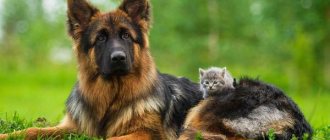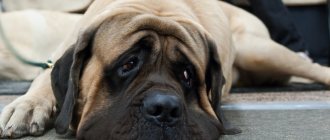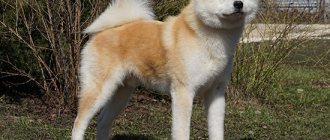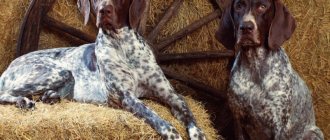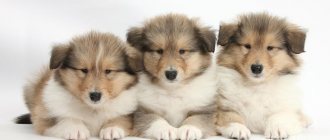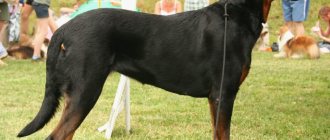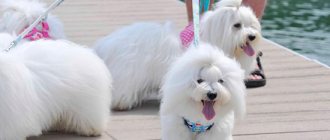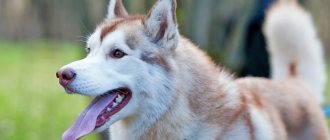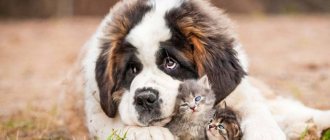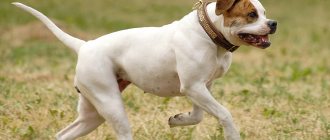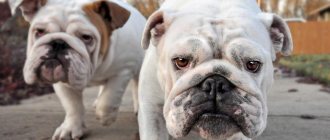Crossing the Pekingese with various dogs is a problem that deserves special attention, since we are talking about the oldest breed, dating back at least 2000 years of existence.
If we talk about a cross between the Pekingese and other breeds, it means a responsible and correct attitude towards animals, which does not allow the mating of non-purebred representatives of the breeds, as well as dogs with very different standard sizes, especially if the female is much smaller than the male. Childbirth can destroy the expectant mother.
Crossing dogs with related conformations (for example, Pekingese + Pug, Pekingese + Shih Tzu), on the contrary, gives interesting results. The main question facing breeders is how to obtain offspring with the desired characteristics. This applies not only to the appearance, but also to the mental health of animals. Unfortunately, a successfully bred litter does not guarantee a positive result in future generations.
However, currently in the field of dog breeding there is an “interesting” trend - the crossing of genetically heterogeneous dogs in order to obtain mixed breeds. Experiments of this kind have come to be called “designer dog breeding,” and the result of such actions is proudly called a “designer dog.” Let’s make a reservation right away: we are not talking about breeding a new breed, which has a strict scientific basis, but getting animals that do not belong to any breed.
Why is this necessary?
Mixing different breeds has both positive and negative results.
The positive points include:
- An original exterior that combines the features of both parents.
- With a successful combination of circumstances, healthier offspring, free from genetic diseases of both varieties.
- It is possible to accidentally breed a unique, hitherto unknown breed.
To obtain this effect, you must adhere to two basic rules:
- Only crossbreeding of purebred individuals is allowed.
- Subsequently, the best representatives from the same designer mixtures are paired. For example, two individuals born from a mixture of Pekingese and Labrador , or a cross between a spaniel and a Pekingese.
The negative aspects are a continuation of the positive ones...
The litter may turn out to be unsightly, combining the most incompatible elements of the parents’ exterior.
- Puppies may be weaker and less viable than their parents.
- Such dogs are not yet recognized by dog handlers around the world. This means that we will have to forget about exhibitions and breeding.
- The result of crossing is poorly predictable: puppies with an unpredictable character, inappropriate behavior and other genetic abnormalities may be born.
And yet, the cute cuties of the mixed Pekingese are increasingly in demand among dog lovers.
One has only to look at the sweet faces of a cross between a Pekingese and a lapdog , a mixture of a Shih Tzu and a Pekingese , and you will immediately want to become their owner. The coat of Pekingese crossbreeds , depending on the dominant gene, can be different in length, color and hair structure. And the Pekingese, with a long muzzle and elongated nose, has no problems with breathing, so the most negative trait is absent - he does not snore in his sleep.
History of the breed
The ancestor of the Pekingese is called an ancient Chinese dog called “toy” . It was smaller than modern representatives, but the exterior was similar. Mixing the blood of Toys with other dogs of similar sizes led to the appearance of the first Pekingese.
From this moment on, the life of the imperial dogs can be called heavenly. They lived exclusively in the palaces of their generous masters. They had their own minister, spacious bamboo pens with beds, quality care and personal servants. They were decorative dogs; they were not used for service or protection; in temples they were worshiped along with deities.
Pekingese were bred only for rulers and those close to them. Among the common people, fluffy dogs with a specific facial expression were not found. The theft of such pets was severely punished regardless of the status of the offender. Only the emperor had the right to give a puppy.
Chinese culture is famous for its mythical tales. According to one legend, the Pekingese is the fruit of love between a lion and a monkey . When the king of beasts fell in love, he suffered greatly. Buddha helped him and reduced him in size. The winged lion won the favor of the monkey, from which small Pekingese dogs were born.
Small dogs with a short muzzle and long feathering became a real symbol of happiness and prosperity among the imperial dynasties. They were depicted on frescoes, and sculptures with their silhouettes were installed at the palace entrances. The rulers dedicated poems to these aristocrats of the dog world and carried them with them, pressing them to their bodies. They were very angry with the servants if the pets were sick or sad.
The turning point in the history of the breed coincided with the coup d'etat in China. The government was overthrown by the people, numerous bloody uprisings caused the introduction of foreign troops into imperial territory. When the rebels reached the royal mansion, the emperor decided to burn them to the ground. Not only buildings were damaged, but also innocent dogs. The British military managed to save several Pekingese and take the unfortunate animals to Europe.
Thus began a new stage for the breed. In England they were considered very expensive dogs and were presented as valuable gifts. An ordinary person could not buy such a puppy; there were cases when tens of thousands of pounds were offered for a dog, but the owners steadfastly refused to sell their pets.
The British managed to accustom some Pekingese to shepherd service, and they managed to work almost as well as shepherds. But such use contradicts the true purpose of a companion dog. In addition, the structure of the body and respiratory tract of Pekings does not allow them to move for a long time and actively, especially when chasing livestock.
Modern Chinese representatives of the breed are mostly descendants of English dogs . They were imported by enthusiasts after the easing of the government regime in the eastern country.
In 1891, British dog handlers recognized the breed and gave it the name “Pekingese.” They offered other options, for example, “Peking Chin”, “Peking Pug”, “Peking Spaniel”. They were brought to the USSR in the middle of the 20th century. There was a large population in Leningrad and the region. Later, Pekingese became popular and remained at the top of the list of common breeds until the mid-90s.
At the same time there was a change in the breed standard. “Old-type” or Soviet dogs gave way to short-legged and fluffier representatives. However, both groups can participate in exhibitions and have offspring with paperwork.
Types of Pekingese crossbreeds
- A Pekingese mixed breed is a mixture of two purebred individuals or a purebred Pekingese and a mongrel . This article is about this type of animal.
- The Pekingese phenotype is puppies born from the mating of two purebred parents, but without a pedigree. Such dogs are not allowed for exhibition activities and breeding.
- A breeding individual is the result of the mating of two highly purebred parents with good pedigrees. This is the pride of nurseries. Such dogs are highly valued.
As for the care and maintenance of a cross between the Pekingese and other breeds, they remain the same indoor decorative dogs that require the attention of their owners, needing care and affection in the same way as their purebred relatives.
The Pekingese is a fluffy, adorable and slightly clumsy baby with the mane of a lion and the face of a monkey.
Looking at him, it’s hard to resist affection and treats.
However, dogs of this breed have long been accustomed to increased attention and pampering.
Once upon a time, their habitat was not small apartments, but the palaces of Chinese emperors.
Moreover, they did not have to wait at the door for the owner to return from work - food was brought to them by servants, guided by the ringing of bells on their collars.
Kinds
Today the breed is classified into 2 types: standard and dwarf. Pekingese breeders are still arguing about whether the second species can be isolated as a separate species on their own. The reason for such disagreements is that in one litter of classic Pekingese there can be 1 dwarf. His gene set is a kind of mutation. This dog has smaller dimensions and weight: up to 22 cm in height and up to 2.5 kg.
Dwarf Pekingese are much more expensive than standard ones because they are born very rarely. As for dog inserts, each of these two breed types is allowed to participate. That is, a standard Pekingese can compete with a dwarf one. At the same time, each of them will not have any concessions.
Miniature decorative dogs have always been more valuable. They are easy to carry, beautiful, elegant and unusual. The Dwarf Pekingese is absolutely no different from its “traditional” counterpart except for size and weight.
These dogs also differ in coat color. The most common shade is sand. It is very rare that snow-white dogs are born without any pigmentation. Such animals are called “albinos”. Unfortunately, they are classified as a genetic marriage. The reason is the lack of a black “mask” on the face, which all Pekingese have.
What does an adult pet look like in the photo?
“A small dog is a puppy until old age” - this saying perfectly describes the appearance of adult Pekingese.
Due to their breed characteristics, they retain “childish” features throughout their lives . Otherwise, it is a strong, stocky and short-legged dog, whose weight does not exceed 5 kg.
The main distinguishing feature of this breed from others is its extremely flattened muzzle. This is especially noticeable if you look at the dog from above - its muzzle seems completely flat.
The ears hang down to the sides and are shaped like hearts . The head is large, massive, with a characteristic transition from a flat forehead to a muzzle.
The snub nose is located at eye level. The eyes themselves are round, convex, dark brown in color. The neck is short, smoothly blending into the chest.
The purebred Pekingese has a bushy tail, like a squirrel .
It is located quite high and curled onto the back. Sometimes its tip touches the dog's head.
Price
Pekingese is a common breed in Russia, so its price is low. If the word “pedigree” doesn’t mean anything to you, and you just want to have a beautiful “lion” at home, you can purchase it from a private breeder. The price of a Pekingese (without pedigree) is from 1 to 5 thousand rubles.
If you want to buy a pet with a guarantee of its health, you will have to go to the nursery to get it. There you will be offered a Pekingese at a higher price, from 8 to 25 thousand rubles.
When buying a puppy, be sure to inquire about the health of its parents. If you have the opportunity to see them, be sure to take it. You must understand that you are purchasing a dog in excellent health, without any defects.
There are many cases of buying sick dogs, which were subsequently abandoned by the owners, since long-term treatment of the dog was not part of their plans. Therefore, to avoid any hassle in the future, thoroughly study the health of your Pekingese puppy before taking it home with you. A healthy dog of this breed should be active, moderately active and inquisitive. It will respond to your every movement and sound.
Breed standard
According to breed standards, a purebred Pekingese must meet the following criteria::
- Head : large and strong. The length of the skull is less than the width. The transition from head to back is pronounced. The forehead is wide and flat.
- Muzzle : wide and strong. A light, continuous fold stretches from the back of the nose to the cheeks. It should not cover the lower eyelids and nose - this spoils the appearance and makes breathing difficult. The lower jaw is strong, pronounced, and protrudes slightly forward. The lips are black, carefully covering only the teeth and tongue - the chin should be open. The nose is also black, wide with large, rounded nostrils.
- Teeth : small, white, without visible spaces. The incisors are level and close together in a tight bite. If the lower and upper incisors are “staggered”, this is considered a minor flaw, but not a defect.
- Ears : fluffy and voluminous. The cartilage at the base fits tightly to the head. They should not hang below the muzzle.
- Eyes : round, medium in size, eyelids with black rims, expressively convey emotions. “Third eyelid” and too bulging eyes are a sign of culling.
- Body : rectangular, with a clearly defined waist. The back is strong and straight: the waist and withers are not pronounced. The chest is rounded and located just below the elbows.
- Paws : stand parallel to each other. The front ones are spaced slightly wider than the rear ones. On the hind legs, the hock joint is clearly visible, pubescent to the ground.
- Tail : set high and carried over the back (left, right, back)
- Coat : straight, hard, medium length. There are feathers on the tail and back of the paws. A collar is formed from wool around the neck.
Character and temperament
According to the observations of dog handlers and owners, Pekingese dogs have the following “breed” character traits:
- Attachment . These dogs quickly get used to their family members and have difficulty withstanding even short-term separation.
- Mind . Pekingese quickly understand how and who can be manipulated, which they use to beg for desired treats and affection. To direct their intellectual abilities in a positive direction, you will have to make a lot of effort.
- Waywardness . Pekingese will only obey a command if they see an immediate benefit in doing so. It’s quite difficult to get used to prohibitions.
- Touchiness . The Pekingese shows with all his appearance that you can’t raise your voice at him and feed him something he doesn’t like. However, it goes away very quickly.
- Selfishness . The Pekingese believes that all attention should be paid to him. Be prepared for the dog to start competing with other pets and even children.
- Passivity . Pekingese are active only when they are puppies. With age, the dog becomes more and more phlegmatic and prefers to while away the time lying on the bedding or the owner's lap.
- Security qualities . The Pekingese does not tolerate when a stranger encroaches on its territory, and always expresses its displeasure with a loud, ringing bark and growl. If the “stranger” seems dangerous or too aggressive to him, he may attack and bite.
Pekingese, despite their miniature size and passivity, are not a priori an ideal pet for an apartment.
They are very “talkative” and constantly make some sounds: whine, grunt, snore, grumble, growl . Keep this in mind if silence in your home is important to you.
Education and training
Small dogs learn too. Sometimes owners neglect this, citing the decorative breed. In most cases, Beijingers are able to learn commands. The training process will be more difficult and longer than with service breeds (German shepherds, Malinois, Dobermans).
A good instructor will help you learn a general obedience course and get a diploma, because one of their main tasks is to “educate” the dog’s owner and teach him how to interact with it.
A Canadian psychologist scientist has compiled data about dogs into a single list. He determined learning abilities by the number of repetitions of commands to execute them. On this list, the Pekingese was in the very last group with the worst results .
However, this indicates that stubborn and independent dogs require a special approach and more time to train. The final result also depends on the qualities of the dog.
Varieties: Chinese, royal, imperial (photos)
On message boards you can often see similar publications: “Imperial Pekingese puppies”, “real Chinese Pekingese”, “Royal Pekingese” - all this is nothing more than a publicity stunt.
If we talk about purebred and standard, then there are no varieties of Pekingese.
However, they really got a dog “like the emperor,” because he also had an ordinary Pekingese.
Also, many people confuse Japanese Chins with Pekingese, believing that these are two varieties of the same breed. It's not like that at all. They differ in everything - from external parameters to character traits.
Be sure to pay attention to this when choosing a pet.
Main types of colors
The following types of colors for Pekingese are recognized as standard::
- Ginger . Varies from red to golden shades.
- Fawn . From milky to nutty. The muzzle is outlined with a black mask.
- Black . Looks very attractive. Most often used at exhibitions.
- Black and Tan . Tan markings are superimposed on a black background. Dogs of this color come with or without masks.
- Black and white . Individuals with this color are distinguished by shorter fur.
- White . Pekingese is the only dog breed in which full albinos are likely to appear. Albinism is a disqualifying feature, but is highly valued among lovers of “exotics.”
With any of the above colors, a small white spot on the forehead is acceptable . In ancient China, it was believed that such a mark made the dog a lucky talisman for its owner and called it “the kiss of Buddha.”
Colors such as grey, brown (liver), red, light fawn and spotted are also possible . However, such individuals are not allowed for further breeding and exhibitions.
Smooth-haired and long-haired
Based on their coat type, Pekingese dogs are divided into two types::
- Longhair (standard) . The guard hair is straight, of medium length, the undercoat is soft to the touch and quite thick. Females have a luxurious collar on their neck. Males have a lion's mane. On the hind legs the fur forms soft trouser legs, and on the front legs there are noticeable fringes. The fur is longest on the ears and tail.
- Smooth-haired or short-haired . Officially, this type of breed does not exist, but sometimes there are representatives with shorter fur than usual. For example, the black and white Pekingese. Their coat is of medium length, without a thick undercoat. There are no featherings on the ears, but the tail is still the fluffiest part of the body.
Often, under the guise of short-haired Pekingese, sellers offer outbred dogs, crosses with a spaniel, chin or other breeds of similar type.
Maintenance and care of Pekingese
Pekingese are kept in apartments, but, like other breeds, these dogs need walking . Many representatives of this breed are not big fans of walking, so you can limit yourself to 15-20 minutes outside. Adult dogs are walked 3 times a day, puppies are walked at least 5 times a day.
thick, long coat requires careful grooming . The pile is combed at least once a week with a comb and brush. The fur on the paws around the pads needs to be trimmed. hygiene procedures include : trimming nails, washing the folds on the bridge of the nose, cleaning the ears, and bathing.
Read more about caring for Pekingese...
What do boys and girls look like? Main differences
Unlike most breeds, the females of the Pekingese are larger than the males . Males weigh up to 5 kg, while females can weigh 500-800 grams heavier.
Breeders often give preference to boys due to their more pronounced breed qualities . Their fur coat is richer, the color is more interesting, and molting occurs only twice a year in the off-season. They participate in exhibitions more often than females.
The girls look more modest - instead of a chic mane, they have a fluffy collar. Shedding occurs not only in the off-season, but also during estrus and after childbirth.
If you have children, give preference to a female Pekingese . Thanks to her natural maternal instinct, she tolerates increased attention from children more calmly.
What to feed your Pekingese
You should definitely ask the breeder what the puppy was fed before. The diet in the first days in a new home should not be radically different. The transition to other foods should be gradual.
Puppies are fed at least 6 times a day. Gradually the frequency of meals is reduced. The menu should include rice, buckwheat, oatmeal, and millet porridges. Fermented milk products and cottage cheese are also suitable for your baby.
Upon reaching 9 months, the dog is fed 2 times a day. The main menu of an adult dog should consist of beef, pork, lamb, poultry, and rabbit meat. Porridge is not excluded from the diet. Adult Pekingese benefit from fresh and thermally processed seasonal vegetables and fruits.
Puppies – in detail, from 1 month to a year
The following table clearly demonstrates the development of the Pekingese from birth to one year:
| Puppy age | Options |
| From birth to two weeks | Weight 150-250 gr. Pekingese puppies are born blind and deaf, but have a sense of taste and touch. They react only to the temperature and smell of the mother. |
| From two weeks to a month. | Weight 0.4-0.7 kg. The puppies still feed exclusively on their mother's milk, but are no longer showing interest in solid food. The eyes become photosensitive, and ear openings appear. |
| From 4 to 12 weeks. | Weight - 0.8-1.2 kg. All physically important functions are finally formed, but active growth continues. The dog begins to master the skills of social behavior, displays character traits and tests the boundaries of what is permitted. At the age of 5 weeks, the puppy begins to be separated from its mother. This period ends at approximately 7-10 weeks. |
| From 3 to 7 months | Weight 1.3-5.8 kg. Weight at 4 months is equal to half the weight of an adult. The teeth are replaced with permanent ones. The puppy takes a defensive position towards others, so at this age it is important to pay maximum attention to socialization. |
| Puppy weight at 10-12 months | Weight 3.2-6.5 kg. By 10 months, growth is complete, but chest girth will continue to increase for another 4 months. Teeth replacement is complete. By 7-10 months, bitches begin their first heat, which lasts 3-4 weeks. In males, the stage of puberty begins with marking territory and aggressive behavior towards other dogs. |
To prevent your puppy from encountering inflammatory diseases, take care of his hygiene (folds on the face, ears, nose, eyes), since due to the peculiar structure of his body he cannot fully take care of himself.
Reproduction and lifespan
As you know, small dogs live a little longer than large ones. So, under the right conditions, the Pekingese can please you from 16 to 18 years. Among them there were also those who reached 20 years of age. The following factors can shorten the life of an animal and worsen its quality:
- Poor nutrition.
- Lack of proper care.
- Rare exposure to fresh air.
- Insufficient physical activity.
A Pekingese bitch is mated to a male dog on about the 4th day of her heat. It is recommended to breed dogs at least 3 years old. This is the ideal age for them to breed. A dog under 2 years old is considered not mature enough for mating, therefore, there is no need to expect strong and healthy puppies from him.
Note! Childbirth in females of this breed often occurs with complications. This is due to the specifics of their exterior (large body and miniature size). Therefore, when a dog goes into labor, it is recommended to take it to a veterinary clinic. Never assist in giving birth to a Pekingese yourself.
To get healthy puppies, it is recommended to select a “dad” who will be smaller in size than the “mother”. In this case, the probability of successful birth of strong puppies is higher.
How to choose?
Before choosing a puppy, decide for what purpose you want to get a dog. For exhibitions, cables are best suited, for home and breeding - females.
At the first meeting with you, judiciously, and first of all, examine the external condition of the dog.:
- Eyes: shiny and clear. No tearing or litter. The look is meaningful, interested.
- Nose and ears: no discharge or scratching.
- Paws: strong, no lameness.
- Stool: hard, without traces of blood. There should be no traces of loose stool under the tail.
- Puppies' behavior: puppies actively take part in general play. Show interest when demonstrating toys.
- Behavior of a nursing bitch: the female behaves warily towards the guest, but does not show unnecessary aggression.
Two-month-old puppies can be taken for home keeping . For participation in exhibitions - babies who have reached 6 weeks.
Be sure to pay attention to the conditions in which the nursing mother and puppies are kept . If breeders refuse to show you the entire litter, citing quarantine, then you shouldn’t trust them.
It is likely that the litter contains puppies with severe culling or infectious diseases.
Origin of the breed
The Pekingese is one of the most ancient breeds of dwarf dogs - their history lasts for 2000 years. There are many beautiful Chinese legends about the origin of puppies. Previously, this animal was very expensive and noble, worthy only of Chinese emperors. Separate rooms were set aside for them in the palaces, they lived strictly under guard, and ordinary people were even forbidden to look at them. But after the Civil War, the breed began to disappear. All because the communists considered such expensive puppies a stupid toy of the rich.
During the Opium War with China, England, the USA and France, several individuals were stolen and taken to England. Two specimens were given to the Duke and Duchess of Richmond and Gordon and Queen Victoria. The puppy was named Lootie. They were considered rare in Europe, but from 1860 to 1890 they were exported as contraband. The name of the breed was chosen based on the capital of China.
Origin story
The history of the Pekingese dates back to Ancient China, where these dogs were bred more than two thousand years ago. There, Pekingese were considered a gift from Buddha and guardian spirits of the ruling dynasty, and therefore only members of the imperial family could keep them.
Taking Pekingese out of the territory of the Celestial Empire was considered a terrible crime, and the one who kidnapped the dog from the palace faced the death penalty.
But sometimes puppies, as a sign of special favor, were presented to people who had rendered special services to the imperial dynasty, and sometimes even foreigners were among them.
The Pekingese ended up in Europe after Beijing was captured by the British in 1860. The soldiers, having discovered five living dogs in the palace chambers, sent them as a gift to Queen Victoria.
In Britain, for some time they tried to use Pekingese not only as salon dogs and companion dogs, but also for hunting, guarding and herding sheep..
English breeders of the second half of the 19th century wanted to improve the original breed and make it more universal, however, all these attempts were unsuccessful, and the breed began to acquire features that were unusual for it.
As a result, it was decided to return to the original type, thanks to which modern Pekingese look almost the same as their ancestors from Ancient China.
Description of the breed
Representatives of the breed have a very expressive, serious look. This is a small, but proportionally built dog, distinguished by a sense of self-esteem. Let's look at its main external characteristics:
| Appearance | Characteristics |
| Head | large, wide, slightly deep; |
| Scull | wide, moderately voluminous, flat between the ears. Between the eyes - wide. Clearly defined stop; |
| Nose | with a wide, slightly elongated black lobe, large and well-open nostrils. There is a small fold, slightly intermittent, that can stretch from the cheekbones to the back of the nose; |
| Muzzle | short and wide, distinguished by a strong lower jaw; |
| Lips | fit tightly, pronounced chin; |
| Eyes | round, shiny, medium in size. A black outline is required; |
| Ears | heart-shaped, set on the top line of the skull, close to the head. The length does not reach the bottom line of the muzzle. There are luxurious long feathers on the surface of the ears; |
| Neck | thick, large, short; |
| Frame | short, well defined waist, straight top line, wide chest. The ribs are well sprung, the chest is dropped between the forelegs; |
| Tail | set high, reaching to the back. Tossed on the back or side. The coat is long; |
| Shoulders | tilted slightly back, close to the body, like the elbows. The forearms are slightly curved between the elbows and pasterns, giving sufficient space for the ribs; |
| Forelegs | short, strong bones. The dog stands well on its paws; |
| Pastern | inclined, strong, located at a sufficient distance from each other; |
| Front legs | flat, large, slightly turned outward; |
| Hind limbs | strong, muscles well expressed. The articulation angles are moderate, the knees are well defined. Strong and low hock joints. |
| Hind legs | directed straight forward. |
The Pekingese's movements are leisurely and proud, the gait is frontal rolling.
Pekingese standard detailed explanation of the standard description - My Pekingese
Skip to content
Main menu:
×
- home
- News
- History of the breed
- Legends about the Pekingese
- Breed standard
- Types of Pekingese
- Before you buy a puppy
- Agreement
- Documents for a puppy
- stamp and chip
- Eyes
- Ears
- wool
- parasite prevention
- vaccinations
- Pekingese and the heat
- They can help here
- Nutrition
- health
- raising and training a dog
- persistent misconceptions
- Health
Diseases
About the Pekingese breed
Back
DETAILED EXPLANATION OF THE STANDARD
BREEDS OF PEKINGNESE
PEKINGNESE SKELETON
The Pekingese should look square.
Front view:
The top should be straight and wide. The chest is wide. The distance between the forelimbs is large.
Side view:
The body has a deep sternum, tapering towards the waist. The top of the back is level. Located low to the ground.
Overall, the Pekingese is a small dog. If you pick up a Pekingese, it should seem very heavy.
The main highlight of the Pekingese is its character. The Pekingese is a surprisingly stubborn dog. It is this quality that makes the Pekingese self-confident, independent and arrogant. The character of the Pekingese is courageous, bold, but without any aggression, signs of timidity or shyness. On the other hand, the Pekingese is a very loyal dog that will be loyal to its owner all its life.
One of the main decorations of the Pekingese is the head. Massive, proportionally larger in width than in height. A squared-off muzzle is undesirable because it looks ordinary, and a Pekingese should never look like that. Over time, head sizes have been increased and decreased due to fears that breeding dogs with too large heads would cause additional problems during childbirth.
Pekingese forehead
must be low and the top of the head absolutely flat. No rounding is allowed. Since the head should be wide, therefore the distance between the ears should be large. For the overall harmony of the Pekingese's head and facial expression, the correct placement of the ears is very important.
Pekingese ears
should be located at the very ends of the skull. If positioned too high (close to the middle of the skull), the head will appear small and very narrow. If the ears are laid back (i.e., further away from the face), then when the dog moves, the ears will begin to fly back and create the feeling of a scared face. If the ears are too low on the sides of the head, they will give the head a round shape. The ears themselves should not be long, but the hair on them should be as long as possible. There should be a wide distance between the eyes, as well as the ears. Otherwise, facial features will be small and cramped.
Pekingese eyes
must be big. Although the latest standard specifies that they should not be too large. I would like to note that at the beginning of the formation of the breed, they sought to ensure that the eyes were necessarily large, since it was believed that without this quality, the Pekingese’s face would become mediocre. At the same time, the whites of the eyes, when the dog looks forward, should not be visible like bulging eyes. The eyes must be as dark as possible.
Pekingese nose
It is located quite high between the eyes. If you draw an imaginary line through the top of the nose, then it should ideally intersect the center of the eye. The Pekingese's nostrils should be as large as possible and open, in no case compressed as this has a negative impact on health. There is a fold (wrinkle) above the nose. It should not hang over the nose or cover the eyes.
Pekingese jaws
should be exactly the same width as the distance between the eyes. There should be no hint of narrowing in the jaw area, giving the face a heart-shaped appearance. It is the wide, slightly protruding lower jaw that gives the Pekingese an expression of aristocracy. And it feels like the dog is looking down.
The face should have sufficient chin and swelling (pads) on the sides. Otherwise, a “frog” expression will appear. This is when the upper lip hangs over the lower lip instead of closing tightly with it.
The nose, lips and eye rims must have excellent black pigmentation in absolutely any color. Since pigmentation is the color of the skin, not the coat.
Pekingese mouth
. In the first Pekingese standard there was not a word about the teeth or bite of the Pekingese. The only thing that is important is that the dog does not show its teeth or tongue. As the saying goes: “What really happens in the Pekingese’s mouth is one of life’s mysteries.” However, for the jaw to have sufficient width, it should ideally have six incisors, preferably located in a straight line along the lower jaw. And to give strength to the lower jaw, it is better for it to protrude slightly in relation to the upper one.
Pekingese lips
must be even. If the lips are uneven, it means that the lower jaw is adjacent to the upper jaw differently, and symmetry is broken. This is a very serious flaw.
Pekingese neck
should be as short as possible. A Pekingese of regular build, with a short, thick neck, is unable to throw its head up (look at the sky) without causing discomfort to itself. The neck, ideally, should be no more than the width of two fingers.
Pekingese forelimbs
should be short, as the Pekingese's topline should be low to the ground. Since the body is much heavier at the front, the forelimbs must have strong bones. It is the small length and correct “curvature” of the forelimbs that gives the Pekingese its unique manner of movement.
Pekingese chest
should protrude forward and hang across the entire width between the forelegs. There is a relationship between the depth of the chest and the length/curvature of the forelimbs. With irregular limbs, there is not enough room for the chest to sag significantly. The elbows of the forelimbs should fit snugly to the chest.
FORE LIMBS OF THE PEKINGNESE
The hind limbs of the Pekingese are thinner and lighter than the forelimbs. But they shouldn’t be very long. They are located much closer to each other, but do not touch. They should be straight and parallel to each other. There should be an angle formed by the hock joint on the side.
HIND LIMBS OF PEKINGNESE
Pekingese paws
must be thick. They shouldn't look like cats. The Pekingese should not fall on the pasterns. He must stand on pads. The front paws are slightly turned outward (not inward!) When walking, provided that the front is properly structured, there is always a significant space between the front paws. The hind legs face forward and move in a straight line, compensating for the rolling movements of the front part of the body.
Pekingese body
should taper from front to back, resembling a pear shape. The back of the body is much lighter than the front. If you grab a correctly built Pekingese in the middle of the body with one hand, the front part will outweigh it and it will fall. The body as a whole should be very strong and dense (not thick). The topline (from the base of the neck to the tail) is level. The back should not be too long, especially in the lumbar region (from the ribs to the tail).
Pekingese tail
must stand high. The dog should carry it over his back and not vertically. The tail can fall evenly across the entire back on both sides or one or either side. A low tail set will visually lengthen the back. The tail should have an abundance of hair. Ideally, the coat should reach the back of the head. The Pekingese should always carry its tail proudly over its back to show that it is not afraid.
Pekingese wool
- this is a special pride. According to the standard, the coat should be abundant and long, primarily on the mane (in the neck and shoulders). The rest of it should be shorter. Long hair is possible there if it does not hide the lines of the body and does not interfere with movements. Long hair should be on the back of the forelimbs and thighs, and the tail. The ears should have the longest feathers possible, beautifully framing the face. The hair on the fingers should be of such length as not to impede movement.
Pekingese color
can be anything except liver (chestnut) color. All colors are rated the same and the choice of color is only a matter of taste. However, it must be taken into account that the structure of the coat and undercoat may differ somewhat from the color of the coat, as well as some differences in the bone structure. For example: the red color can be very rich and beautiful, but it will be inferior in density to the undercoat of its gray counterparts.
As for the face, it can be either with a full black mask, or with a half mask, or without it.
Pekingese sizes
. This is a very controversial topic and Pekingese sizes are constantly changing. The standard states: “The ideal weight should not exceed 5 kg for males and 5.5 kg for females.” But in practice, Pekingese often exceed these figures, sometimes significantly. If we recall history, initially the Pekingese Club set a threshold of 10 pounds (4.5 kg), but both of the first champions had a weight exceeding this threshold and after some time the threshold was changed to 18 pounds (8 kg), and then completely abolished. However, in 1908, the Peking Palace Dog Association was formed, which again set the threshold at 10 pounds (4.5 kg). Today, many believe that a larger dog with an abundance of hair will win in the ring.
However, do not forget that the first word in the description of the Pekingese is “small”.
Home | News | History of the breed | Legends about the Pekingese | Breed standard | Types of Pekingese | Before you buy a puppy | Agreement | Documents for a puppy | stamp and chip | Eyes | Ears | wool | parasite prevention | vaccinations | Pekingese and the heat | They can help here | Food | health | raising and training a dog | persistent misconceptions | Health | Newbie | Awarding titles | Schedules, catalogs | exhibition reports | I want to go to the exhibition | documents | document forms | by train | by plane | by steamship | They need a home | They found their home | The world around | Questions and suggestions | Forum | Shop for Pekingese | Home Site Map
This site may use cookies.
user agreement
The “My Pekingese” website is for informational purposes only and is not a public offer.
Learn more about cookies.
Using the My Pekingese website means you agree with
Site Map
Amella & Ness
Pros and cons of the breed
Before buying a Pekingese, pay attention to its advantages and disadvantages that each breed has. The advantages of representatives of the breed include:
- excellent immunity;
- easy care;
- reliability, devotion;
- good qualities as a watchman;
- attractive appearance;
- small size, easy transportation;
- no noise.
- poor tolerance to temperature changes;
- snore;
- frequent runny nose due to the specific structure of the muzzle and nose;
- in older age – heart disease.
Long hair and short stature are not a plus: while walking in tall grass, your pet can pick up ticks or fleas. If your dog begins to itch, contact your veterinarian.
Possible diseases and methods of treating them
Pekingese puppies are born very weak. As they grow up, they periodically encounter problems such as eyeball loss. The reason is the deformation of the muzzle. Protruding eye sockets can also become a problem in adults of this breed. It is recommended to solve this problem with the help of a veterinarian, but if you cannot urgently hospitalize the dog, you will have to set his eyeballs back in place yourself.
First you need to wash your hands well, then wrap your index fingers in a bandage. Next, a light pressing movement should be performed. If during the procedure your pet breaks away, he will have to be restrained. You will need the help of a second person.
The loss of eyeballs in a Pekingese cannot be ignored, as this pathology can cause his blindness. A standard preventive measure is regularly wiping the mucous membranes with tea leaves.
Dogs of this breed also have a curved nasal septum, which is why they often make a sound reminiscent of human snoring. If a large amount of mucus accumulates in the animal’s nose, it should be removed. Only veterinarians can do this.
Well, the last alarming symptom indicating the Pekingese’s ill health is shortness of breath. In hot weather, he can easily overheat and begin to choke. Therefore, to prevent this from happening to your pet, trim it in mid-June and do not allow it to walk outside for a long time in high temperatures.
Peculiarities
Pets can be picky eaters and stubborn in other ways. Basically, Pekingese love to lie on the sofa or the lap of one of the family members; their activity phases are short. Dogs treat children well and are affectionate and friendly towards them. They are not always friendly towards strangers, although they behave politely. Training a Pekingese is not an easy process and beginners are advised to be patient. With age they become more and more calm, but they will never refuse the games offered.
Dog and man
Pekingese will be the best friends for the following categories of owners:
- Aged people,
- Homebodies,
- Calm and inactive people.
They will definitely not get satisfaction from the content:
- Athletes,
- Hunters,
- Fans of service breeds.
There are debates about behavior in families with children. Much depends on the genetics of a particular dog, upbringing, including the child. An animal with such a temperament may not seem too affectionate , but it will never be the first to offend a baby. In general, Pekings have shown themselves to be calm and balanced dogs.
The attitude towards other pets depends on the hierarchy. However, most Pekingese get along peacefully with cats and other dogs. They lack the hunting instinct , which is reflected in their behavior.
Pekingese are not suitable for outdoor living. They must grow and exist next to a person, although, at first glance, they seem overly independent. The presence of the owner nearby will ensure a healthy psyche for the pet. In addition, they require careful daily grooming due to their coat.
